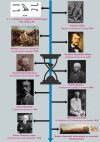History of schistosomiasis (bilharziasis) in humans: from Egyptian medical papyri to molecular biology on mummies
- PMID: 30016215
- PMCID: PMC6225400
- DOI: 10.1080/20477724.2018.1495357
History of schistosomiasis (bilharziasis) in humans: from Egyptian medical papyri to molecular biology on mummies
Abstract
Schistosomiasis is a parasitic infection that has evolved together with the humankind. Evidence in ancient Egyptian medical papyri or Assyrian medical texts reported signs and symptoms that could resemble schistosomiasis; similarly, some biblical passages describe an epidemic (depicted as a 'curse') that has been hypothesized to be associated with schistosomiasis' spread in Mesopotamia. In the modern era, Theodor Maximilian Bilharz and Patrick Manson (the 'father of tropical medicine') gave an impetus to the knowledge about the parasite and its spread until the present time, when immunoassays and molecular biology on mummies allowed retracing important milestones regarding schistosomiasis' evolution. Schistosomiasis affects more than 200 millions of people worldwide and it is an emblem of how hard it is to prevent, control and treat neglected tropical diseases. Our work reviews the history of schistosomiasis with regard to human infections.
Keywords: Egyptian mummies; Human Schistosomiasis; evolution; history; molecular biology.
Figures

References
-
- Bergguist R, Kloos H, Adugna A.. Schistosomiasis: paleopathological perspectives and historical notes In: Jamison B, ed. Schistosoma: biology, pathology and control. Baton Rouge: CRC Press; 2017. p. 8–33.
-
- Standley CJ, Mugisha L, Dobson AP, et al. Zoonotic schistosomiasis in non-human primates: past, present and future activities at the human-wildlife interface in Africa. J Helminthol. 2012June;86(2):131–140. - PubMed
-
- Lai YS, Biedermann P, Ekpo UF, et al. Spatial distribution of schistosomiasis and treatment needs in sub-Saharan Africa: a systematic review and geostatistical analysis. Lancet Infect Dis. 2015August;15(8):927–940. - PubMed
Publication types
MeSH terms
LinkOut - more resources
Full Text Sources
Other Literature Sources
